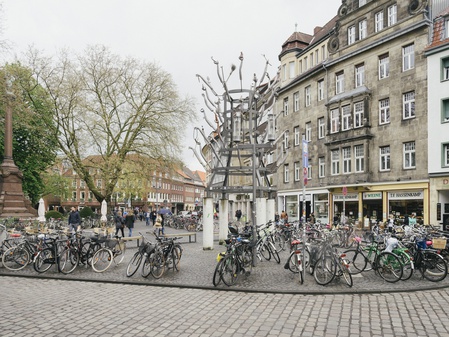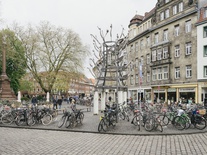Huang Yong Ping
100 Arme der Guanyin [100 Arms of Guanyin]
1997
Steel construction in the form of a bottle rack, 50 modelled casts from three moulds from arms, height 6 m
Location
Traffic island on Marienplatz, south of St. Ludgeri church, removed in 2011, due to building work on Marienplatz, and restored, reinstalled since 2012, permanent installation
Owner
LWL-Museum für Kunst und Kultur, Münster
Acquired with the financial support of the Verein der Kaufmannschaft Münster (merchant league of Münster).
Huang Yong Ping
* 1954 in Xiamen, China
† 2019 in Paris, France
Inspiration for Huang Yong Ping’s sculpture in Münster were both Duchamp’s iconic work Bottle Rack (1914) and the statue of Christ in the St. Ludgeri church, whose arms had been destroyed in a bombing raid during the Second World War.1 Instead of bottles, his six metre high bottle rack is equipped with 50 modelled arms, which in turn reference the Buddhist Goddess Guanyin.2 Whilst the Goddess’ 1000 hands hold religious objects, Huang Yong Ping has placed everyday objects, familiar to a European public, in his sculpture’s hands.
However, Huang Yong Ping’s work is not simply a European counterpart, and even though he addresses elements common to Chinese and European culture, it is above all their differences he is highlighting. The artist merges the bottle rack and the Goddess in a hybrid which is both an object and human.
Huang Yong Ping was a cofounder of Xiamen Dada, a group of artists who, after Mao’s death, began looking to Western avant-garde art.3 He has lived in Paris since 1989 and worked on monumental sculptures and installations which deal with Chinese culture.4 In Münster the obvious irreconcilability of the arms and bottle rack emphasises his interest in Dadaistic approaches. Whilst he frequently employs such strategies in his work to undermine the pathos of socialist realism, in this case they serve him in negotiating issues of postcolonialism. The mechanistic combination of elements is an ironic gesture demonstrating the complexity of cultural exchanges.
Stefanie Raupach
1 Klaus Bußmann, Kasper König, and Florian Matzer (eds.), Skulptur. Projekte in Münster 1997, exhib. cat.: Westfälisches Landesmuseum für Kunst und Kulturgeschichte, Münster, Ostfildern-Ruit 1997, 223.
2 Ibid.
3Edward L. Davis (ed.), Encyclopedia of Contemporary Chinese Culture, London 2005, 373.
4Hou Hanru, A necessary Reminder. In: De Appel (publ.), Huang Yongping, exhib. cat.: De Appel, Amsterdam 1998, 65.
Location
- Still existing / Public Collection
- Removed
- In the museum

